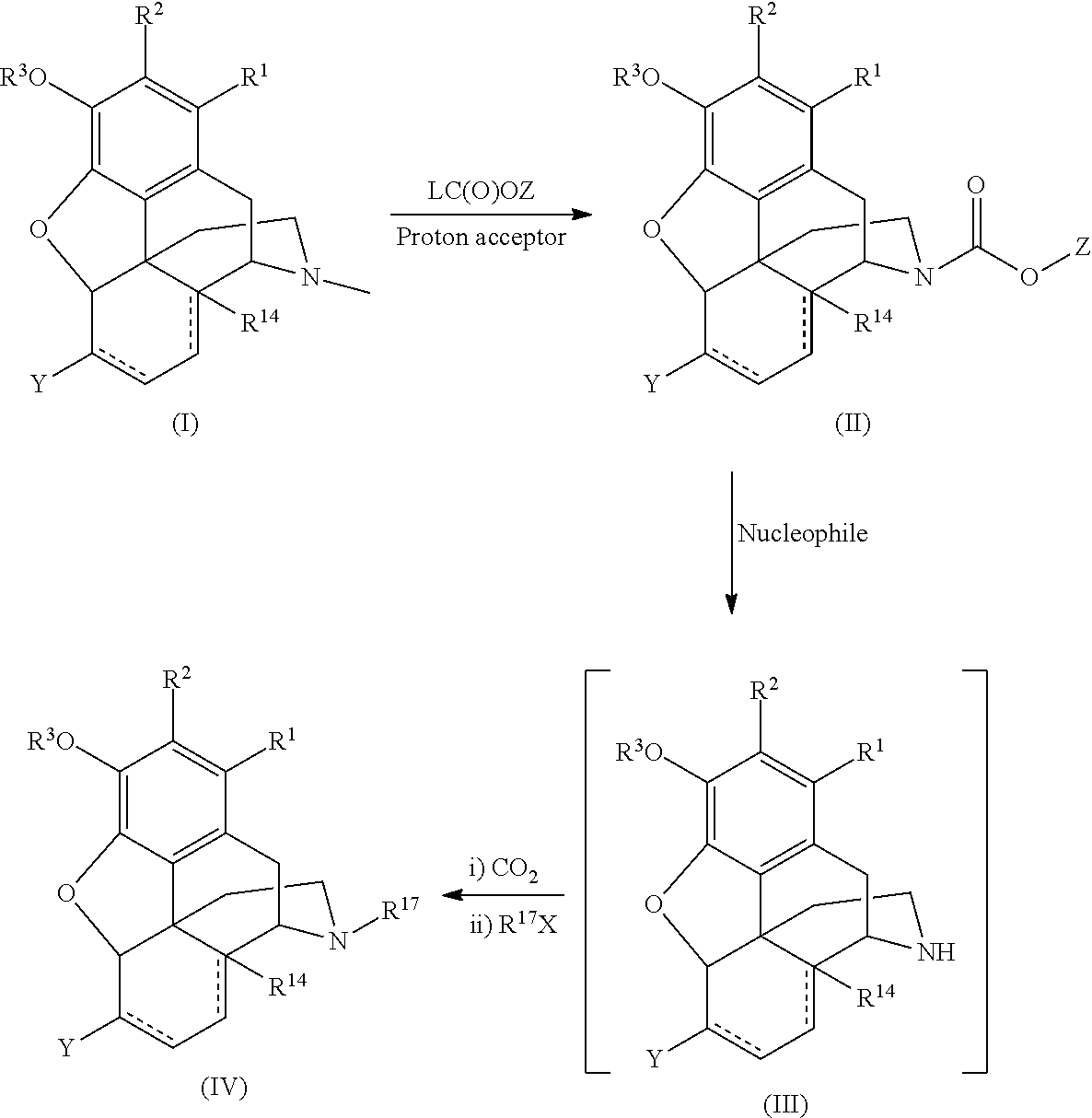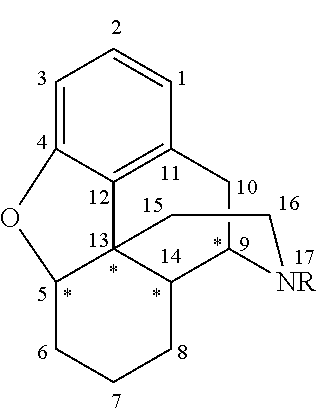Tandem Process for Preparing N-Alkyl Morphinans
a technology of alkyl morphinans and n-alkyl morphinans, which is applied in the field of preparation of nalkyl morphinans, can solve the problems of long time-consuming isolation process and achieve the effect of improving the stability and stability of the ionization process
- Summary
- Abstract
- Description
- Claims
- Application Information
AI Technical Summary
Problems solved by technology
Method used
Image
Examples
example 1
Synthesis of 17-phenylcarbomatyl-4,5-epoxy-3-methoxy-cyclic 1,2-ethanediyl acetal-(5α)-morphinan-6-one—Trial 1
[0096]The following reaction scheme depicts the demethylation reaction:
[0097]A mixture of 17-methyl-4,5-epoxy-3-methoxy-cyclic 1,2-ethanediyl acetal-(5α)-morphinan-6-one 1 (32.4 g), sodium bicarbonate(23.8 g), and chloroform (145 mL) was prepared in an ice bath (and cooled for 10 min). To the cooled mixture was added phenyl chioroformate dropwise. The resulting mixture was gradually heated to 53° C. for two hours. HPLC analysis indicated the reaction was complete. The mixture was filtered. The solid was washed with CHCl3 (2×20 mL). The solution was added to ice-cooled 5% Na2CO3 (145 mL). The organic phase was separated and the aqueous phase was extracted with CHCl3 (2×60 mL). The combined organic phases were washed with water (2×100 mL). The organic layer was evaporated on rotar-vapor and gave a foam solid, 44.7 g crude material. Part of the crude product (29.7 g) was re-cr...
example 2
Synthesis of 17-phenylcarbomatyl-4,5-epoxy-3-methoxy-cyclic 1,2-ethanediyl acetal-(5α)-morphinan-6-one—Trial 2
[0098]A mixture of 17-methyl-4,5-epoxy-3-methoxy-cyclic 1,2-ethanediyl acetal-(5α)-morphinan-6-one 1 (1.0 g), sodium bicarbonate (0.74 g), and ethyl acetate (5 mL) was cooled in ice bath for 10 min. To the cooled mixture was added phenyl chloroformate (0.44 mL) dropwise. The resulting mixture was gradually heated to 50° C. for three hours. After cooling to room temperature, 5 mL of water was added to the reaction mixture and the phases were allowed to separate. The organic phase was removed, and the aqueous phase was extracted with ethyl acetate (2×5 mL). The combined organic phases were washed with 1.0 N sodium hydroxide solution (2×5 m), 2.5% HCl solution (2×5 mL), and then dried over anhydrous sodium sulfate. After filtering over drying agent, the filtrate was evaporated in vacua and gave 1.3 g, purity=82%.
example 3
Synthesis of 17-(cyclobutylmethyl)-4,5-epoxy-3-methoxy-cyclic 1,2-ethanediyl acetal-(5α)-morphinan-6-one
[0099]The N-alkyl compound was prepared according to the following reaction scheme:
[0100]A mixture of 17-phenylcarbomatyl-4,5-epoxy-3-methoxy-cyclic 1,2-ethanediyl acetal-(5α)-morphinan-6-one 2 (1 g), toluene (4 mL), DMSO(1 mL), and powdered KOH (0.5 g) was prepared under nitrogen and heated to 86° C. (in an oil bath) for two hrs. HPLC monitoring of the reaction indicated that the reaction was complete. The reaction mixture was cooled to room temperature. Carbon dioxide was bubbled through the reaction mixture for 10 min, and plenty of white precipitate was formed. To the reaction mixture was added 2 mL dry DMF, followed by the addition of bromomethylcyclobutane (0.27 mL). The resulting mixture was heated at 75° C. overnight. After HPLC monitoring indicated that the reaction was done, the mixture was cooled to room temperature. To the reaction mixture was added 80 mL ethyl acetat...
PUM
| Property | Measurement | Unit |
|---|---|---|
| temperature | aaaaa | aaaaa |
| temperature | aaaaa | aaaaa |
| pKa | aaaaa | aaaaa |
Abstract
Description
Claims
Application Information
 Login to View More
Login to View More - R&D
- Intellectual Property
- Life Sciences
- Materials
- Tech Scout
- Unparalleled Data Quality
- Higher Quality Content
- 60% Fewer Hallucinations
Browse by: Latest US Patents, China's latest patents, Technical Efficacy Thesaurus, Application Domain, Technology Topic, Popular Technical Reports.
© 2025 PatSnap. All rights reserved.Legal|Privacy policy|Modern Slavery Act Transparency Statement|Sitemap|About US| Contact US: help@patsnap.com



